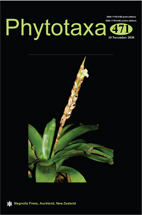Abstract
Twenty species of Polyosma are currently recorded for Borneo, ten are new and they are described here: P. cyanoides, P. dewildei, P. fulva, P. glabrescens, P. grandiflora, P. matangensis, P. melanophylla, P. murudensis, P. parvifolia and P. pseudobracteosa. Provisional conservation assessments are made for all the newly described species. One species is assessed Endangered (EN), four Vulnerable (VU), one Near Threatened (NT), one Least Concern (LC) and three Data Deficient (DD).
References
<p class="Reference">APG IV (2016) An update of the Angiosperm Phylogeny Group classification for the orders and families of flowering plants: APG IV. <em>Botanical Journal of the Linnean Society</em> 181 (1): 1–20.</p><p class="Reference"> <a href="https://doi.org/10.1111/boj.12385">https://doi.org/10.1111/boj.12385</a></p><p class="Reference">Ashton, P.S. (1995) Biogeography and ecology. <em>In: </em>Soepadmo, E. & Wong, K.M. (Eds.) <em>Tree Flora of Sabah and Sarawak</em> Vol. 1. Forest Research Institute Malaysia, Sabah Forestry Department and Sarawak Forestry Department, pp. XLIII–LI.</p><p class="Reference">Atlas of Living Australia website, <em>Polyosma</em>. Available from: <a href="https://bie.ala.org.au/species/https%3A/id.biodiversity.org.au/taxon/apni/51300982#classification">https://bie.ala.org.au/species/https%3A//id.biodiversity.org.au/taxon/apni/51300982#classification</a> (accessed 11 October 2020)</p><p class="Reference">Bachman, S., Moat, J., Hill, A.W., de la Torre, J. & Scott, B. (2011) Supporting Red List threat assessments with GeoCAT: Geospatial conservation assessment tool. e-Infrastructures for data publishing in biodiversity science. <em>ZooKeys</em> 150: 117–126.</p><p class="Reference"> <a href="https://doi.org/10.3897/zookeys.150.2109">https://doi.org/10.3897/zookeys.150.2109</a></p><p class="Reference">Backer, C.A. & Bakhuizen van den Brink Jr., R.C. (1964) <em>Escalloniaceae</em>. <em>Flora of Java </em>Vol. 1. P. Noordhoff Ltd., Groningen, pp. 506–508.</p><p class="Reference">Beaman, J.H., Anderson, C. & Beaman, R.S. (2001) <em>The Plants of Mount Kinabalu</em> Vol. 4. Natural History Publications (Borneo), Kota Kinabalu, pp. 276.</p><p class="Reference">Bennett, J.J. (1840) <em>Polyosma</em>. <em>Plantae Javanicae Rariores</em>, pt. 2, H. Allen et socios, London, pp. 193–196.</p><p class="Reference">Blume, C.L. (1826) <em>Polyosma</em>. <em>Bijdragen tot de Flora van Nederlandsch Indie</em>, pt. 13, Ter Lands Drukerij, Batavia, pp. 658–659.</p><p class="Reference">Elmer, A.D.E. (1913) Philippine <em>Polyosma</em>. Leaflets of Philippine Botany 5: 1633–1639.</p><p class="Reference">Esser, H.-J. (2017) Polyosmaceae. <em>In: </em>Santisuk, T., Balslev, H., Newman, M., Barfod, A. & Esser, H.-J. (Eds.) <em>Flora of Thailand</em> Vol. 13 part 3. The Forest Herbarium, Department of National Parks, Wildlife and Plant Conservation, Bangkok, pp. 538–545.</p><p class="Reference">Esser, H.-J. & Saw, L.G. (2015) A new species of <em>Polyosma</em> (Escalloniaceae/Polyosmaceae) from Thailand and new synonyms. <em>Phytotaxa</em> 221 (1): 89–92.</p><p class="Reference"> <a href="https://doi.org/10.11646/phytotaxa.221.1.10">https://doi.org/10.11646/phytotaxa.221.1.10</a></p><p class="Reference">Heine, H. (1953) Diagnoses novae plantarum in Borneo septentrionali a J. et M.S. Clemens Lectarum. Pars II. <em>Mitteilungen der Botanischen Staatssammlung München.</em> 1 (6): 208–207.</p><p class="Reference">Index Herbariorum (2020) <a href="http://sweetgum.nybg.org/science/ih/">http://sweetgum.nybg.org/science/ih/</a> (accessed 7 October 2020)</p><p class="Reference">IUCN (2012) <em>IUCN Red list categories and criteria</em>. Version 3.1. 2nd edition. Gland. Switzerland and Cambridge. UK: IUCN, iv + 32 pp.</p><p class="Reference">Lundberg (2016) Polyosmaceae. <em>In:</em> Kubitzki, K., Kadereit, J.W. & Bittrich, V. (Eds.) <em>Families and Genera of Vascular Plants </em>Vol. 14. Springer International Publishing, Switzerland, pp. 291–294.</p><p class="Reference"> <a href="https://doi.org/10.1007/978-3-319-28534-4_28">https://doi.org/10.1007/978-3-319-28534-4_28</a></p><p class="Reference">Merrill, E.D. (1921) Saxifragaceae. <em>Journal of the Straits Branch of the Royal Asiatic Society</em>, Special Number: 286–287.</p><p class="Reference">Merrill, E.D. (1923) <em>Polyosma</em>. <em>An Enumeration of Philippine Flowering Plants</em> Vol. 2. Bureau of Printing, Manila, pp. 220–221.</p><p class="Reference"> <a href="https://doi.org/10.5962/bhl.title.49412">https://doi.org/10.5962/bhl.title.49412</a></p><p class="Reference">Merrill, E.D. (1928) A collection of plants from Sarawak. Saxifragaceae. <em>Sarawak Museum Journal</em> 3: 523–524.</p><p class="Reference">Pillon, Y. (2018) Nomenclature and typification in <em>Polyosma</em> (Escalloniaceae) from New Caledonia, with the description of a new species. <em>Phytotaxa</em> 371 (4): 267–272.</p><p class="Reference"> <a href="https://doi.org/10.11646/phytotaxa.371.4.4">https://doi.org/10.11646/phytotaxa.371.4.4</a></p><p class="Reference">Saw, L.G. (1989) Saxifragaceae. <em>In: </em>Ng, F.SP. (Ed.) <em>Tree Flora of Malaya</em> Vol. 4. Longman Malaysia. Petaling Jaya. pp. 462–469.</p><p class="Reference">Saw, L.G. (2004) A new species of <em>Polyosma </em>(Escalloniaceae) from Sabah, Malaysia. <em>Sandakania</em> 14: 57–59.</p><p class="Reference">Saw, L.G. (2010) Vegetation of Peninsular Malaysia. <em>In:</em> Kiew, R., Chung, R.C.K., Saw, L.G., Soepadmo, E. & Boyce, P.C. (Eds.) <em>Flora of Peninsular Malaysia. </em>Series II: Seed Plants. Vol. 1. Malayan Forest Records No. 49, Forest Research Institute Malaysia, Kepong, pp. 21–45.</p><p class="Reference">Saw, L.G. (in press) A new species of <em>Polyosma</em> Blume (Escalloniaceae) and notes on the revision of the genus in Peninsular Malaysia and Singapore. <em>Gardens’ Bulletin Singapore</em> 72.</p><p class="Reference">Schlechter, R. (1914) Die Saxifragaceae Papuasiens. <em>Botanische Jahrbücher fur Systematik</em> 52 (1–2): 118–138.</p><p class="Reference">Soltis, D.E. & Soltis, P.S. (1997) Phylogenetic relationships in Saxifragraceae <em>sensu lato</em>: A comparison of topologies based on 18S rDNA and rbcL sequences. <em>American Journal of Botany</em> 84: 504–522.</p><p class="Reference"> <a href="https://doi.org/10.2307/2446027">https://doi.org/10.2307/2446027</a></p><p class="Reference">Stapf, O. (1894) On the flora of Mount Kinabalu in North Borneo. Saxifragaceae. <em>Transactions of the Linnean Society of London, 2nd series: Botany</em> 4: 148–149.</p><p class="Reference"> <a href="https://doi.org/10.1111/j.1095-8339.1894.tb00044.x">https://doi.org/10.1111/j.1095-8339.1894.tb00044.x</a></p><p class="Reference">Stevens, P.F. (2001 onwards) Angiosperm Phylogeny Website. Version 14, July 2017 [and continuously updated since]. Available from:http://www.mobot.org/MOBOT/research/APweb/ (accessed 7 October 2020)</p><p>Wallich, N. (1824) <em>Itea</em>. <em>In:</em> Roxburgh, W. (Ed.) <em>Flora Indica</em>, Vol. 2. W. Thacker & Co., Calcutta and Allen & Co., London. pp. 418–421.</p>

